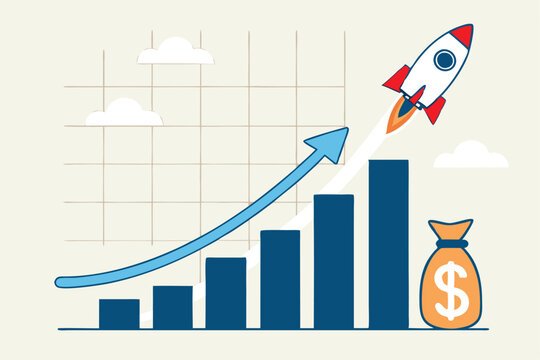The Most Powerful Force in Personal Finance—Explained Simply
💬 “Compound interest is the eighth wonder of the world. He who understands it, earns it… he who doesn’t, pays it.” — Albert Einstein
This quote isn’t just poetic—it’s financial truth.
Whether you want to build wealth, retire rich, or just make your money work harder, understanding compound interest is the first step.
🧠 What is Compound Interest?
Compound Interest is the interest you earn on both your original money (principal) and the interest you’ve already earned.
In simple terms:
Your money earns interest, and then that interest also earns interest.
Over time, this creates a snowball effect where your wealth grows exponentially.

📊 Simple Interest vs. Compound Interest
| Feature | Simple Interest | Compound Interest |
|---|---|---|
| Earned On | Only the principal | Principal + accumulated interest |
| Growth | Linear | Exponential |
| Formula | P × R × T / 100 | P(1 + R/100)^T – P |
P = Principal
R = Rate of Interest
T = Time (years)
💡 Example: ₹10,000 at 10% Annual Interest for 5 Years
| Year | Simple Interest (SI) | Compound Interest (CI) |
|---|---|---|
| 1 | ₹1,000 | ₹1,000 |
| 2 | ₹1,000 | ₹1,100 |
| 3 | ₹1,000 | ₹1,210 |
| 4 | ₹1,000 | ₹1,331 |
| 5 | ₹1,000 | ₹1,464 |
| Total | ₹5,000 | ₹6,105 |
Result: Compound interest earns ₹1,105 more over 5 years—with zero extra effort.
🚀 Why Compound Interest is a Game-Changer
1. Time is Your Best Friend
The earlier you start, the more time your money has to grow.
₹1 Lakh invested at 12% annually:
- After 10 years = ₹3.10 Lakhs
- After 20 years = ₹9.65 Lakhs
- After 30 years = ₹29.95 Lakhs
That’s 30x your money—just by letting it sit and grow.
2. Small Amounts Matter
Even small, regular investments become massive due to compounding.
Invest ₹2,000/month via SIP at 12% return:
- 10 years = ₹4.6 Lakhs invested → ₹4 Lakhs interest → ₹8.6 Lakhs total
- 20 years = ₹4.8 Lakhs interest → ₹17 Lakhs total
- 30 years = ₹17 Lakhs interest → ₹35 Lakhs total
🔁 How Compound Interest Works: Step-by-Step
Let’s break it down with an example:
Scenario:
You invest ₹50,000 at 10% annual interest, compounded yearly.
Year 1:
- Principal = ₹50,000
- Interest = ₹5,000
- New balance = ₹55,000
Year 2:
- Interest = 10% of ₹55,000 = ₹5,500
- New balance = ₹60,500
Year 3:
- Interest = 10% of ₹60,500 = ₹6,050
- New balance = ₹66,550
Each year, your base amount increases—and so does your interest.
That’s compounding in action.

📅 Compounding Frequency Matters
Interest can be compounded:
- Annually (once a year)
- Quarterly (4 times/year)
- Monthly (12 times/year)
- Daily
The more frequent the compounding, the faster your money grows.
₹1,00,000 at 10% for 10 years:
- Annually: ₹2.59 Lakhs
- Quarterly: ₹2.71 Lakhs
- Monthly: ₹2.71+ Lakhs
- Daily: ₹2.72 Lakhs+
🛡️ How to Use Compound Interest to Your Advantage
✅ Start Early
The earlier you start, the more time your money has to compound—even if you’re investing small amounts.
✅ Be Consistent
Use SIPs (Systematic Investment Plans) to invest monthly and automate compounding.
✅ Reinvest Your Returns
Don’t withdraw your earnings. Reinvest them to unlock true compounding power.
✅ Choose High-Growth Assets
Stocks, mutual funds, and index funds compound faster than savings accounts or FDs.
⚠️ How Compound Interest Can Work Against You
Credit cards and loans also use compound interest—but in reverse.
The longer you delay payments, the faster your debt explodes.
A ₹1 Lakh credit card balance at 36% interest can grow to ₹3 Lakhs+ in just 3 years if unpaid.
So—earn compound interest, don’t pay it.
💬 Final Thoughts: Master the Money Multiplier
Compound interest is not just a finance term—it’s a life strategy.
It rewards:
- Patience
- Consistency
- Early action
If you understand it and use it, it can make you rich.
If you ignore it, it can keep you broke.
🧠 TL;DR – Quick Recap
- Compound interest = Earning interest on interest
- It grows your money exponentially, not linearly
- The longer your money stays invested, the faster it grows
- Start early, invest consistently, reinvest returns
- Use SIPs or long-term growth funds
- Avoid credit card debt where compound interest works against you








